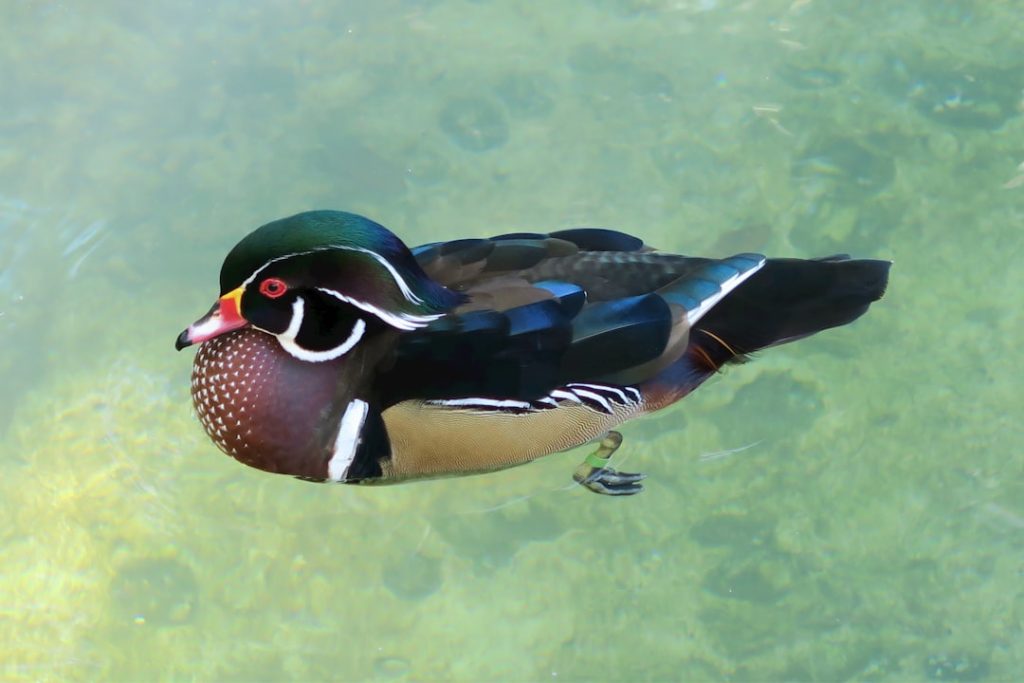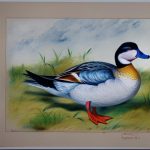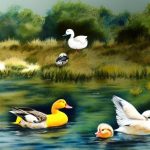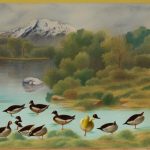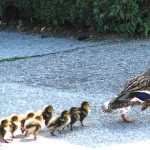Mallard ducks, scientifically known as Anas platyrhynchos, are one of the most recognizable and widespread duck species in the world. They are native to North America, Europe, and Asia, and have also been introduced to other parts of the world. Mallards are highly adaptable and can be found in a variety of habitats, including wetlands, marshes, lakes, rivers, and even urban areas. They are known for their distinctive iridescent green heads, white neck ring, and chestnut-brown chest. Mallard ducks are also known for their characteristic quacking sound, which is a familiar sound in many wetland habitats.
Mallards are highly social birds and are often seen in large flocks, especially during migration. They are omnivorous and feed on a variety of foods, including aquatic plants, insects, small fish, and crustaceans. Mallard ducks are also popular game birds and are hunted for sport and food in many parts of the world. Despite being a common sight in many areas, mallard ducks face threats from habitat loss, pollution, and hunting pressure. Conservation efforts are underway to protect and manage mallard populations to ensure their long-term survival.
Table of Contents
Key Takeaways
- Mallard ducks are a common and widespread species of duck found throughout North America, Europe, and Asia.
- Male mallard ducks have a distinctive glossy green head, while females have a mottled brown plumage.
- Mallard ducks are adaptable and can be found in a variety of habitats, including lakes, rivers, marshes, and urban areas.
- Mallard ducks are known for their unique courtship displays and nesting habits, often building their nests in hidden locations near water.
- Mallard ducks are a popular game bird for hunters and are also enjoyed by birdwatchers and wildlife enthusiasts.
Physical Characteristics of Mallard Ducks
Mallard ducks are medium-sized waterfowl with a body length of around 20-28 inches and a wingspan of 32-39 inches. They have a distinctive appearance with the male mallards, known as drakes, sporting a glossy green head, white neck ring, chestnut-brown chest, and gray body. Female mallards, known as hens, have a mottled brown plumage that provides excellent camouflage in their natural habitat. Both males and females have a bright blue patch on their wings, which is visible during flight.
Mallards have a characteristic bill that is yellowish-orange with a black tip. Their legs and feet are also orange, which helps to distinguish them from other duck species. In flight, mallards are fast and agile, with a rapid wingbeat and a distinctive whistling sound. Their iridescent green heads and colorful plumage make them one of the most easily recognizable duck species in the world. Mallard ducks are also known for their ability to hybridize with other duck species, leading to a wide range of plumage variations and color patterns.
Behavior and Habitat of Mallard Ducks
Mallard ducks are highly adaptable birds that can be found in a wide range of habitats, including freshwater lakes, rivers, marshes, and coastal estuaries. They are also commonly found in urban areas, where they can be seen in parks, ponds, and even swimming pools. Mallards are highly social birds and are often seen in large flocks, especially during the winter months when they gather in large numbers at wintering sites.
Mallards are omnivorous and feed on a variety of foods, including aquatic plants, insects, small fish, and crustaceans. They are also known to forage on land for seeds and grains. Mallards are dabbling ducks, which means they feed by tipping forward in the water to reach food below the surface. They are also strong swimmers and can dive underwater to escape predators or search for food. Mallards are also known for their distinctive quacking sound, which is used for communication within the flock.
Mallards are migratory birds and can be found in different parts of the world throughout the year. They breed in northern regions during the summer months and migrate southward to warmer areas during the winter. Mallards form pair bonds during the breeding season and build nests in secluded areas near water. They are also known for their elaborate courtship displays, which involve the male performing various behaviors to attract a mate.
Reproduction and Nesting Habits of Mallard Ducks
Mallard ducks are monogamous birds that form pair bonds during the breeding season. The courtship display of mallards involves the male performing various behaviors to attract a mate, including head bobbing, tail wagging, and vocalizations. Once a pair bond is formed, the female selects a nesting site and builds a nest using grasses, reeds, and other plant materials. The nest is usually located near water in a secluded area to provide protection from predators.
The female mallard lays a clutch of 8-13 eggs over a period of 2 weeks, with one egg laid per day. The eggs are an olive-green color and are incubated by the female for around 26-30 days. During this time, the male mallard will often stand guard nearby to protect the female and the nest from potential threats. Once the eggs hatch, the female leads the ducklings to water where they can feed and grow.
Mallard ducklings are precocial, which means they are born with their eyes open and are able to feed themselves shortly after hatching. The mother provides protection and guidance to the ducklings as they learn to swim and forage for food. Mallard ducklings grow quickly and are able to fly within 2-3 months after hatching. Mallards are known for their high reproductive potential and can produce multiple broods in a single breeding season.
Mallard Ducks as a Popular Game Bird
Mallard ducks are one of the most popular game birds in the world and are hunted for sport and food in many parts of their range. They are prized for their fast flight and challenging behavior, making them a favorite target for waterfowl hunters. Mallards are also known for their delicious meat, which is lean and flavorful when properly prepared.
Hunting regulations for mallard ducks vary by region and are often managed through hunting seasons and bag limits to ensure sustainable populations. Many hunters use decoys and calls to attract mallards to their hunting blinds or boats. Hunting dogs are also commonly used to retrieve downed ducks from the water. Mallard hunting is a popular tradition that has been passed down through generations and is an important part of many cultural traditions.
In addition to hunting, mallard ducks are also raised on farms for meat production. Domesticated mallards are bred for their meat and eggs and are an important source of protein in many parts of the world. Mallard meat is lean and flavorful with a rich taste that is prized by chefs and home cooks alike.
Conservation and Management of Mallard Ducks
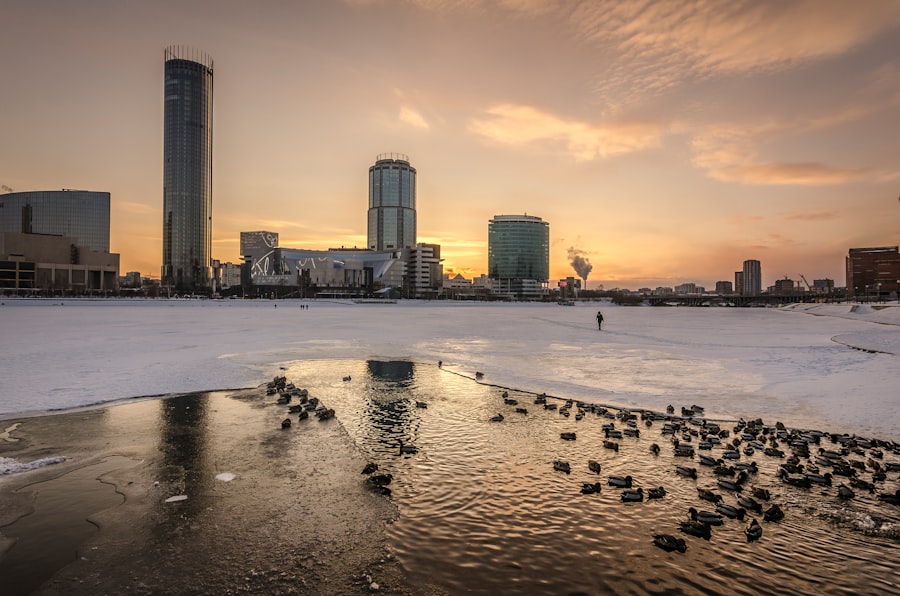
Mallard ducks face threats from habitat loss, pollution, climate change, and hunting pressure. Conservation efforts are underway to protect and manage mallard populations to ensure their long-term survival. Wetland conservation is an important part of mallard management as these birds rely on healthy wetland habitats for breeding, feeding, and resting during migration.
Hunting regulations play a key role in managing mallard populations and ensuring sustainable harvest levels. Bag limits, hunting seasons, and habitat management programs help to maintain healthy mallard populations while providing recreational opportunities for hunters. Conservation organizations work with government agencies, landowners, and hunters to promote responsible hunting practices and habitat conservation.
In addition to hunting regulations, habitat restoration projects help to improve wetland habitats for mallards and other waterfowl species. These projects involve restoring natural wetland features such as water levels, vegetation, and food sources that benefit mallards during different stages of their life cycle. Wetland conservation also provides benefits for other wildlife species and helps to improve water quality and reduce flooding in many areas.
Mallard Ducks in Popular Culture
Mallard ducks have long been featured in popular culture as symbols of beauty, grace, and freedom. They have been depicted in art, literature, music, and film as iconic symbols of nature’s beauty. Their colorful plumage and graceful flight have inspired artists and writers for centuries.
Mallard ducks have also been featured in children’s stories and cartoons as lovable characters with distinctive personalities. Their quacking sound is often used as a sound effect in movies and television shows to evoke a sense of nature or outdoor settings. Mallards are also popular subjects for wildlife photography and birdwatching enthusiasts who appreciate their beauty and behavior.
In addition to their cultural significance, mallard ducks play an important ecological role as seed dispersers and insect predators in wetland habitats. They help to control insect populations and spread seeds of aquatic plants as they move between different wetland areas. Mallards also provide food for predators such as foxes, raccoons, and birds of prey as part of the natural food web.
In conclusion, mallard ducks are fascinating birds with distinctive physical characteristics, behavior patterns, and cultural significance. They play an important role in ecosystems as seed dispersers, insect predators, and prey for other wildlife species. Conservation efforts are essential to protect mallard populations from threats such as habitat loss, pollution, climate change, and hunting pressure. By working together to conserve wetland habitats and manage hunting practices responsibly, we can ensure that mallard ducks continue to thrive for future generations to enjoy.
If you’re interested in learning more about duck breeds, particularly the popular mallard, you might also want to check out this informative article on chicken coop door size on PoultryWizard. Understanding the importance of the right coop door size can help ensure the safety and comfort of your ducks and other poultry. It’s a great resource for anyone looking to create a suitable living environment for their feathered friends. (source)
FAQs
What are the different breeds of ducks?
There are many different breeds of ducks, including the popular Pekin, Mallard, Rouen, and Khaki Campbell. Each breed has its own unique characteristics and traits.
What is a Mallard duck?
The Mallard duck is a common and widespread breed of duck that is native to North America, Europe, and Asia. It is known for its distinctive iridescent green head and bright orange bill.
What are the characteristics of Mallard ducks?
Mallard ducks are medium-sized with a body length of around 20-26 inches and a wingspan of 32-39 inches. They have a mottled brown body, a blue patch on their wings, and a white ring around their neck.
What is the behavior of Mallard ducks?
Mallard ducks are highly adaptable and can be found in a variety of habitats, including lakes, rivers, marshes, and coastal waters. They are known for their distinctive quacking call and are often seen in large flocks during migration.
What do Mallard ducks eat?
Mallard ducks are omnivorous and feed on a variety of foods, including aquatic plants, insects, small fish, and crustaceans. They are also known to forage for food on land, grazing on grasses and grains.
Are Mallard ducks good for domestication?
Mallard ducks are commonly domesticated and are popular for their meat and eggs. They are also kept as pets and for ornamental purposes due to their attractive plumage and calm demeanor.
Meet Walter, the feathered-friend fanatic of Florida! Nestled in the sunshine state, Walter struts through life with his feathered companions, clucking his way to happiness. With a coop that’s fancier than a five-star hotel, he’s the Don Juan of the chicken world. When he’s not teaching his hens to do the cha-cha, you’ll find him in a heated debate with his prized rooster, Sir Clucks-a-Lot. Walter’s poultry passion is no yolk; he’s the sunny-side-up guy you never knew you needed in your flock of friends!

